History of Gilberdyke, East Yorkshire
This is a summary of the history of the village of Gilberdyke, which today has a population of over 3,000 people. It was once a tiny farming community on the edge of the swampy common of Wallingfen and situated alongside Gilbert's dyke. Below is information about Gilbert Hansard and the dyke, about Gilberdyke windmills, chapels, the flax mill and the pole yard.
Gilbert's dyke - Gilberdyke chapels - Windmills - Flax mill - Pole yard
Click here to view further old photos of Gilberdyke.
Gilbert's dyke
The site of the village of Gilberdyke was originally a marshy waste, part of the manor of Howden, granted to the Bishops of Durham by William the Conqueror. Hugh de Puiset, who was Bishop of Durham from 1154 to 1190, made several land grants to tenants in the area on the understanding that they would improve the land.
Between 1154 and 1160 a grant of land was made to Gilbert Hansard who originated from Walworth Castle in County Durham. In return for a quarterly payment of three marks (£8 a year) Gilbert became the hereditary tenant of "the territory of Blacktoft and the fishery appertaining thereto" apart from the land which already belonged to William de Blacktoft and the bishopric's own fishery. More importantly, Gilbert was granted the right to build a mill on his property and bring water to power it through from the "land in Foulney" (ie. near the River Foulness).
Gilbert Hansard constructed a new water-course or dyke which ran from east of Hive (Sandholme probably did not exist then) to the river Ouse at Blacktoft. It was dug by 1191, since it is referred to in a document of that date as the "fosse of Gilbert Hansard".
By 1399 the dyke was described as 16 feet wide and 8 feet deep. A settlement developed along the banks of the dyke, in particular where it crossed the Howden to Cave road. By 1234 the settlement was known simply as "Dyc". This became extended to "Gilbert's dyke" and was first recorded as Gilberdyke by 1376. The dyke itself was probably navigable by small boats.
It ran - and still does - down the west side of Clementhorpe Road, across the crossroads and alongside Sandholme Road. It continues down Hansardam ('Hanserrdam' on some road signs) towards the 'Foona' (the River Foulness).
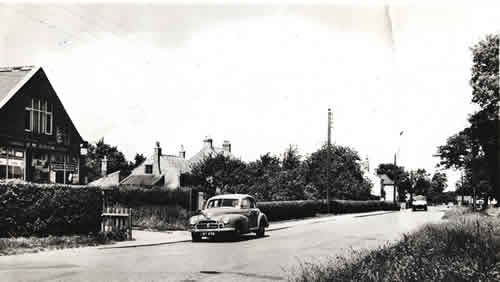
Above is Clementhorpe Road, Gilberdyke with 'Bunt' Cook's shop on the left
The nearby settlements of Bellasize, Bennetland and Sandholme also
first appear in the fourteenth century, no doubt as a result of
the improved drainage of the area. The settlement of Scalby is probably
of an earlier date.
The presence of the nearby five thousand acre common of Wallingfen probably explains why the three arable fields round the village of Gilberdyke consisted of only a hundred and fifty acres altogether. These fields were known as North, South and Middle Fields and were used to grow wheat and barley. However, these grain crops could be supplemented by food from Wallingfen.
The village grew only slowly. In 1539 there were 52 able-bodied men in "Dyke cum Sandholme". In 1672 there were 58 households in Gilberdyke and, by 1801, there were 64 houses and 337 people living there.
In 1777 the 3000 acre Bishopsoil Common was enclosed. Laxton Grange was built - so called because the land on which it stands was allotted to Laxton in the enclosure of Bishopsoil. In fact, adjoining land is still owned by Laxton Church.
In 1822 Gilberdyke had two carpenters (Thomas Oldfield and John Ward), two blacksmiths (John Handley and John Wade), a shoemaker (John Ramsey), a miller (Nathaniel Bell) and a schoolmaster (William Sharp). Five farmers were listed - Isaac Hairsine, William Lee, John Pacy, John Rennison and John Waterhouse. Also listed was Joseph Hutchinson, the landlord of the Cross Keys. William Lawton was the overseer of the poor.
The Act of Parliament to enclose the open fields around the village was passed in 1830 and the work was complete by 1833. The surveyor was John George Weddall of Selby and the Commissioner John Bell of nearby Portington.
Chapels
Wesleyan Methodist
In 1846 a Wesleyan Methodist Chapel was built north of the Howden/Hull road. This was converted into a private house in 1920 and is now known as "Norgill". The present Methodist chapel was opened in 1893.
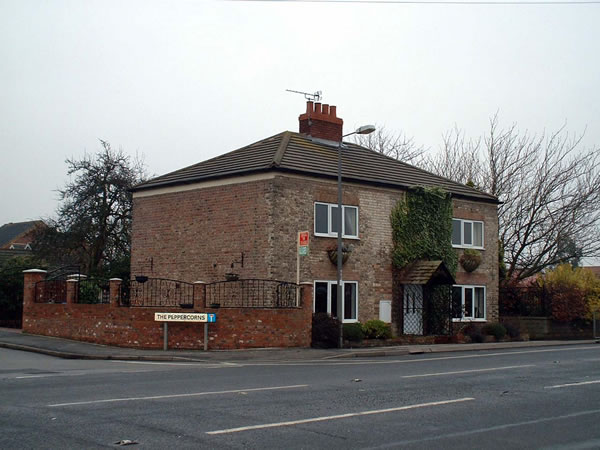 .
.
This house on the corner of the entrance to The Peppercorns was once a chapel
Primitive Methodists
Also in 1846, a Primitive Methodist Chapel was built just to the north of the village smithy which stood on the site of the present village hall.
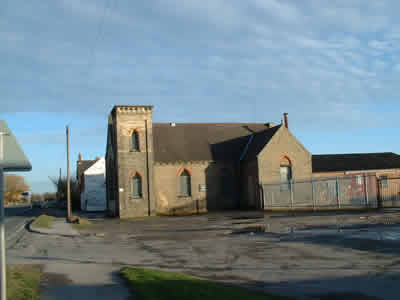
Above is Gilberdyke Primitive Methodist chapel which was funded by the Walmsley family. Until recently it was Claytons' agricultural engineers and is now the site of Claytons Fold.
In 1899 a new Primitive Methodist chapel was built opposite the school. This was later used from about 1940 as an agricultural merchants by Messrs Clayton. It has now been demolished and houses built on the site.
Church of England
On April 18th 1855 a combined Church of England school and chapel was opened between Gilberdyke and Newport, paid for by the Reverend J. Dunnington-Jefferson who preached "three powerful sermons" that day. The building was used as a school (Scalby School) during the week and as a church on Sundays. It became redundant when the Scalby Board school was built at Gilberdyke (now a residential and nursing home) in 1895 and Newport Church was opened in 1899. It is now a private house.
Windmills
Gilberdyke had at least two windmills. The earliest mill was Bishopsoil Mill which stood on the eastern edge of the old Bishopsoil common and today is the site of Mill Farm, west of Thornton Dam Lane. Bishopsoil Mill was originally a post mill. The mill and Mill Garth were owned by Nathaniel Bell in the early 1800s. In 1812 it was described as "a post windmill with substantial dwelling house, brick and tiled, situate at Sandholme".
In January 1839 there was a terrible storm which blew down several local mills including the Bishopsoil one. It was probably after this that the mill was rebuilt in brick. It was sold in 1854 to John Jewitt. The mill was sold again in 1865 to the Morrell family who also owned Laxton Grange. The mill fittings were offered for sale in 1893, as were 70,000 bricks. It seems likely that this was the demolition date of the mill.
The second Gilberdyke mill was built on the east of Greenoak Lane after the enclosure of Bishopsoil Common. Locally it is remembered as 'Stather's Mill'. It was built on land which was allotted to the parish of Bellasize in the 1777 enclosure, known as Bellasize Green. When the 1851 census was taken Nathaniel Bell aged 79 years was recorded as living there. He said that he was born there and described himself as a retired miller and farmer. Also living there was Nathaniel Bell junior, aged 40, who was the existing miller, with his own family.
In October 1827 Thomas and Robert Bell, aged four and two years, were both killed by the sails of Gilberdyke mill. They were living at Scalby and their burials are recorded in the Blacktoft Parish Register. Nathaniel Bell died in 1898 but by then the mill was being run by the Harrison brothers. Some people will remember the Stather family who were the next owners of the mill.

Above is a picture taken in the Mill yard when Gilberdyke mill was run by the Bell Harrison family
Mr Harrison Stather operated the mill, mainly grinding grain for cattle feed. His son Mr J. Stather, who was the last owner of the mill, remembers that his father frequently had to get up in the night to take advantage of the wind and it was this unreliability which led to the removal of the sails. The mill was then powered by a tractor which stood in a shed behind the house. Most of the grinding was done during the winter months, since the Stathers were also farmers and worked the land the rest of the year.
The mill building consisted of four storeys. The bottom storey was the working platform; the second storey housed three sets of grinding stones; the third storey held the storage bin for the grain and the fourth storey had a chain and pulley for raising sacks of grain.
The mill began to be uneconomical when farmers began to grind their own grain and was then closed and later demolished. It was the last local mill to close, following the Anti-mill and Newport Mill.
From the late nineteenth century the village of Gilberdyke began to expand and develop as an industrial site. The flax mill and the pole yard brought new families into the village.
The local flax industry
Gilberdyke had a flax industry from about the 1870s
until the 1930s. There were flax mills in other local villages before
this time. For example, Barmby on the Marsh was
described in 1851 as a "well built village housing two manufactories
of coarse linens" although by the 1870s there was only one sacking
manufacturer, John Solomon Thompson, and by 1892 there were none:
John Thompson was by then a yeoman at "Spring field house". At Howden
there was a sacking mill in the 1830s/40s but this closed in 1842
(it was in what today is still called Mill yard).
At Eastrington in 1851 thirteen men were employed in dealing in flax, dressing it and weaving it into coarse cloth suitable for sacking. Four men described as "flax dressers" were locally born, as were the two dealers, William Turner and Thomas Holmes. The weaving, however, was done by men from further afield: John Lazenby, aged 33 was born in Hull, although his wife Margaret was from Carnforth. He was a "master weaver" and employed six men. The birthplaces of the couple's children suggest that they spent some years at Rawcliffe and then in the mid-1840s moved to Butterwick. John Taylor, aged 36, was from Carnforth andhis wife was from Kendal. Thomas Prush, aged 20 and a "sacking weaver", was from Nottingham while another weaver, George Naylor, was originally from Rawcliffe. William King was from Leicestershire but was married to a Barmby girl. John Linley, who described himself as a sailcloth weaver, was from Owston. However, by 1861 there was no weaving industry in Eastrington and no mention of flax.
At Gilberdyke there was no flax industry in 1861 but a few men in Sandholme and Hive worked with flax. In Sandholme there were: William Baxter aged 25, a flax dresser born at Apperley Bridge in Lincolnshire; John Jackson, a flax trader born locally at Bennetland, and John Greensides, a flax scutcher born in Sandholme. In the adjoining hamlet of Hive was William Brown aged 70, a flax dealer employing one man and three boys and originally from Bubwith.
Staddlethorpe Flax Mill
The Gilberdyke flax mill seems to have developed in the 1870s. A large part of what is today Gilberdyke was originally part of the settlement of Staddlethorpe. Edward Oliver, the owner of the flax mill, was a Staddlethorpe farmer in 1871 but by 1881 he was described as a flax scutcher who was employing 35 men, 10 boys and 27 women. He lived with his wife Hannah and his son Thomas Blossom Oliver who was then 28, unmarried and managing the flax mill. There were also daughters Ann, Marguerite, Hannah and Alice and another son, William, an engineer.
The main mill building was west of Station Road and there were scutching rooms, retting ponds, an engine shed, a large chimney, a joiner's shop and a smith although there were other storage buildings across the road and a railway track. All that remains today is the Flax mill pond.
A block of six cottages (Flax mill cottages) was built to house some of the workers on the west side of Station Road. Some of the families who worked in the flax mill were the Winter, Coates, Poole, St Paul, Clayton, Nunn, Carroll and Cooper families.
The Staddlethorpe flax mill declined in the early 20th century until the First World War when it was taken over by the Yorkshire Flax Company and around 300 acres of locally grown flax was processed. The linen fibre produced was needed for military purposes and particularly for aeroplane wings. Production continued after the war but stopped about 1930.
The pole yard
Wade's pole yard occupied the site of the present Gilberdyke industrial estate. The firm of Richard Wade and Sons was originally based in Hull on Raven Street. They imported timber from the Baltic and expanded as the need grew for more sleepers and telegraph poles. More space was needed and so around 1902/3 they bought the site at Staddlethorpe adjacent to the Hull and Selby railway. Wade's Creosoting Works began operations in 1905 and several families were transferred from Hull to the new works. These workmen included members of the Seaman, Hayward, Exley, Grimoldby, Whitehead, Freer, Martin, Nicholson, Hunter, Robinson, Simpson and Goodhand families.
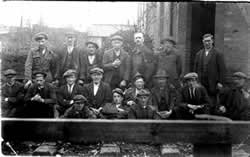
Pole yard workers pictured near Gilberdyke railway station (then known as Staddlethorpe Station). The bridge is in the background.
They were housed in a row of 12 cottages - Wade's Cottages - and two wooden bungalows on the road to Blacktoft which were built in 1905/6. Vast numbers of poles arrived by rail every day (there was a line right into the yard), wet from being in the Hull timber pond. Sometimes as many as two trains of wagons a day were teemed into rough stacks and then later stacked upto thirty feet high to dry out. After about a year they were checked by GPO inspectors, cut into shape and then creosoted. The creosoting plant was steam driven and the creosote arrived by rail from Knottingley. The poles and sleepers remained in the vacuum tank for about an hour. It was a dangerous business and two men at least were killed - George Hunter and Clifford Norton - when a stack of poles once became dislodged.
The yard employed about 50 men but trade began to decline in the 1960s. The yard closed in 1970.
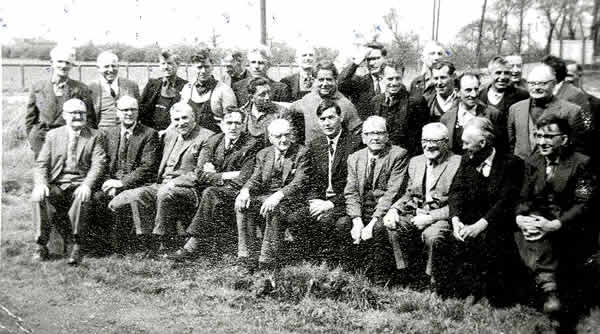
This picture was taken shortly before the pole yard closed.
Back: Freddie Nicholson, unknown, Johnson Norton,
Ken Goodhand, unknown, Tommy Goodhand, Fred Featherstone, Arthur
Crisp, unknown, unknown, Ron Goodhand.
Middle: Arthur Jewitt, unknown, Alf Goodhand, ? Thornham, Dick Walmsley,
? Benson.
Front: Jack Kean, Bert Exley, Stan Hayward, unknown, Charlie Seaman,
Stuart Walter, unknown, unknown, George Simpson.
Visit the old photographs
page to see many more old pictures of Gilberdyke and the local area.
